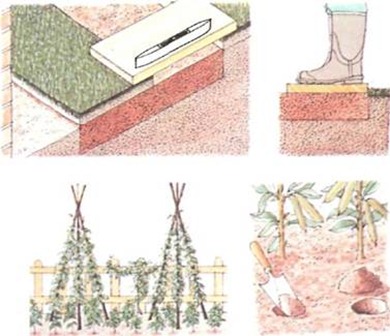





This fortnight we start on the second of our two major, permanent shape-changing tasks. The first was making the patio. Now it’s time to make the lawn look so good it’ll be the envy of others in your street. You’ll see. We plan to change the shape of the lawn to a circle. Once you’ve done yours, don’t be surprised if other people try to copy yours. This one change will do more to improve your garden than any other single change.
The ideal small tree for a small garden should have brilliantly fresh green or shrimp pink young leaves in spring, flamboyant flowers in early summer, eye-eatching fruits in late summer, fiery leaf colour in fall and stunning bark to hold your interest through winter. Trouble is, there’s no one tree that does all of these things. If you’ve got a small garden – only room for one tree -.choose one that has more of these attributes than any other you can find. Probably the nearest comer is a yellow-fruiting crab apple, Mains ‘Golden Hornet’: spring leaves pinkish: flowers early summer, pale pink, prolific; fruits late summer, eye-catching golden-yellow: reddish-purple leaves in fall.
Needs list: 1 pkt broad bean seed; 1 pkt snap bean seed;1 bundle stakes.
Time budget: 6 hours in 2 weeks

Usually the hottest time of the year, this can be marvellous in the garden if there’s sufficient rain to keep growth lush. In dry years bottom leaves will tend to turn brown. Rain, when it comes, can be very heavy, so make sure tall plants are staked securely otherwise they’ll break.
1. Check compost bin. The layers you first put in should be starting to look like good moss peat, light and crumbly to the touch.
2. Continue removing large weeds from the lawn, and keep on cutting it regularly. Now’s the time to repeat the feeding if the lawn feed you used requires a second dosage.
3. Concentrate your watering on newly planted plants and newly turfed lawn.
4. Remove the strongest seedlings from the seed box (Stage 6), lifting with a kitchen fork to make sure you take earth with the roots. Put transplants one to a peat pot, filling the peat pots with a soilless potting mix. Water in.
5. Check on patio levels. Top up any subsidence.
6. If any young sunflowers or vines have failed, sow replacements, and waste no time about it.
7. If your annuals are not in flower yet, clear the bed and sow replacements to flower in late fall.
8. If your bag of moss peat has dried out, soak it so the peat’s wet when you want to use it.
9. Heavy rains may flatten some plants. Stake them upright again; refirm soil round stems. Use hoe to break soil crust.
 A lawn needs to be more than merely green and level and well-mown to look great. It needs to be the right shape for the garden it belongs in. House and garden are one entity: home. Just about everything in the home is square or squared – the doors, the windows, the rooms, the house itself, everything from foundations to fence are basically square.
A lawn needs to be more than merely green and level and well-mown to look great. It needs to be the right shape for the garden it belongs in. House and garden are one entity: home. Just about everything in the home is square or squared – the doors, the windows, the rooms, the house itself, everything from foundations to fence are basically square.
So, unfortunately, are most lawns.
Break away from that shape, round your lawn, and everything else will relax and flow with it. Our lawn is round. If you have a very long garden, have two round lawns. Decide the diameter of the lawn to fit your garden. Ours is 15 ft. Find the centre point of your new lawn. Stick a stake dead centre. Tie a string to it. Tie a peg to the end of the string at the precise radius needed (£ your diameter). Scratch a circle in the turf. Dig and prepare areas to be re-turfed as in Stage 1. With your spade held upright, cut cleanly, following the line of your circle. Then cut parallel lines in the outer part of your lawn, 12 in. apart. Remove turf outside circle – in lengths of not more than 18 in. Lift by pushing your spade under the turf. Use these turves to shape new parts of the lawn. Stack any surplus turves to rot down for the rockery. Check levels with spirit level laid on a board.
Switch to your vegetable patch. Make a tripod of poles for your pole beans, and tie them in. Dig new holes for a second crop of dwarf French or bush snap beans. Plant firmly. Water in.
Two Hour Gardening Project: Stage 26 Climbing Plants and Pergolas
Two Hour Gardening Project: Stage 24 Propagation and Growing Herbs
Two Hour Gardening Project: Stage 23 Principles of Pruning
Two Hour Gardening Project: Stage 21 Making Christmas Present Plants
Two Hour Gardening Project: Stage 20 Tubs and Container Gardening
Two Hour Gardening Project: Stage 18 Choosing Shrubs for the Garden
Two Hour Gardening Project: Stage 17 Fan Trained Fruit Trees
Copyright © www.100flowers.win Botanic Garden All Rights Reserved